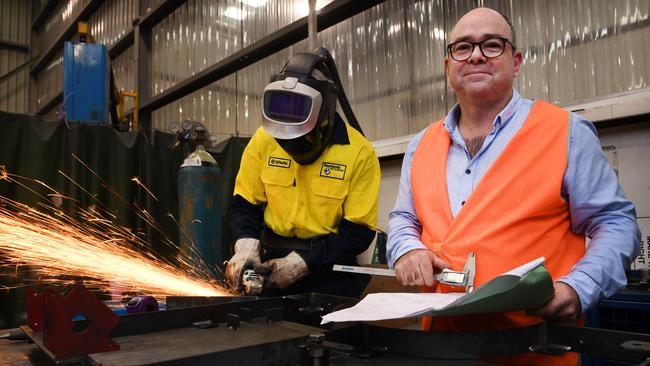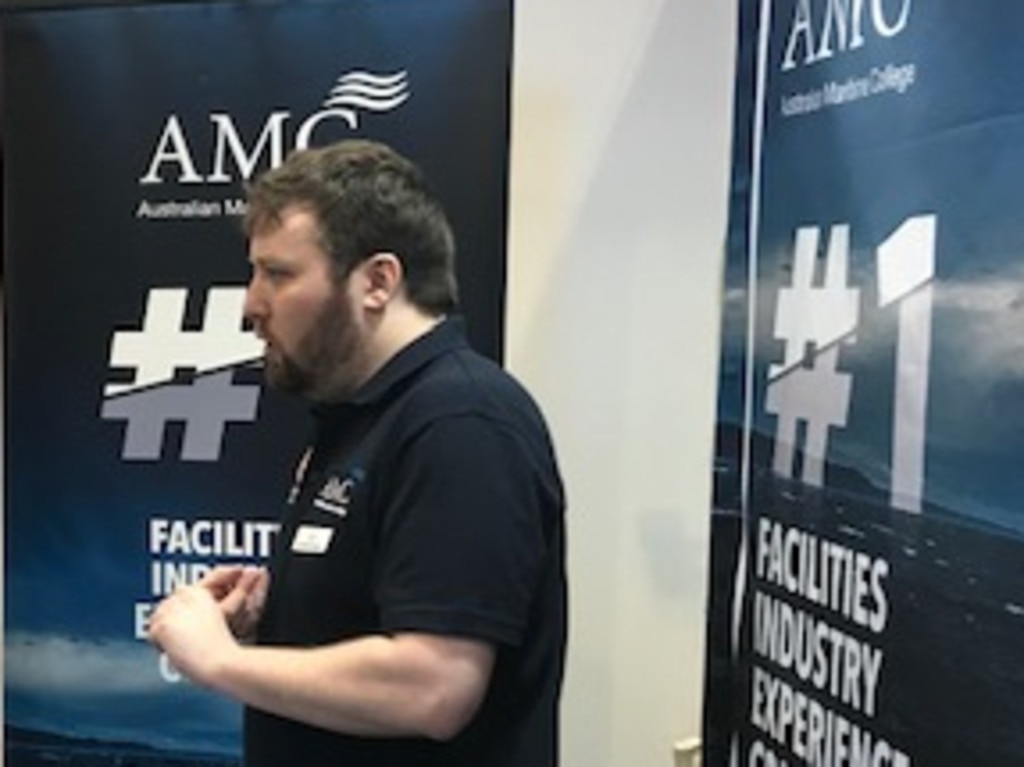Bigger Defence pie is changing businesses
A transformation is happening at the small to medium-sized-enterprise level in Australia with the government’s continuous naval shipbuilding.

A transformation is happening at the small to medium-sized-enterprise level in Australia amid the federal government’s planned continuous naval shipbuilding program, and one of the businesses at the forefront is Rowlands Metalworks.
It is true that bigger and more glamorous companies grab the headlines as they have are chosen for inclusion in the nine Hunter-class future frigates to be built in Adelaide for the Royal Australian Navy, for example.
One such company is Canberra’s CEA Technologies, whose ultra-high tech Ceafar phased array naval radar, will protect the Hunters from attack.
But Rowlands is neither big nor glamorous. Its 60 staff make cabinets in a basic metalworking shop at Lonsdale in southern Adelaide, albeit one dotted with new equipment and staff suddenly buoyed by local and even international success.
Rowlands, along with Electro Optic Systems, Liferaft Systems Australia, Mackay Consolidated Industries and CBG Systems, is among SMEs bidding for work in the $35bn Hunter project from builder, BAE Systems Australia.
The six SMEs have already been integrated into BAE’s global supply chain, and all have supplied equipment being installed by BAE’s British parent in the Type 26 combat ships it is building the Royal Navy in Glasgow.
Rowlands chief executive Cameron Johnston says: “We are a humble steel-metal operation and suddenly we are supplying sheet-metal components that are being installed into ships in the northern hemisphere.
“For us it is a minor commercial sale, but it has also stimulated our esprit de corps. For our guys, it is exciting.”
As a small-business owner, Johnston says supplying the Defence Department’s needs made him face what he calls the SME conundrum.
Should he follow a typical path for a basic manufacturer and coast along, perhaps running his factory gradually down until eventual retirement? Or should he use the greater certainties being offered by naval contracts to transform Rowlands into a business he can pass on or sell?
Johnston chose the latter, dealing with what are known as tier-one suppliers, such as ship navigation and control systems company Raytheon Anschutz, that themselves deal directly with prime contractors such as BAE.
Rowlands is hoping for Hunter contracts to make ship bridge consoles for Raytheon Anschutz, as well as components for heating, ventilation and airconditioning (HVAC) systems through other tier-one suppliers.
“Today defence is dragging us up the technical ability ladder, which is an awesome result for our normal customers,” Johnston says.
“We are investing heavily in new capital equipment and in human capital, we have a technology plan, we have a plan to improve our IT infrastructure, and it sent me personally on an ‘industry 4.0’ journey.”
While local industry involvement in defence in the past was often governed by a crude aim for a certain percentage of ‘‘local content’’, there are now interlocking policies that guide involvement by more than 3000 local SME suppliers.
The Defence Department has identified 10 sovereign industrial capability priorities that are backed by an industry skills plan, a policy for industry participation, an export plan and a global supply- chain program which is guided by the government’s Centre for Defence Industry Capability.
A conference will explore SME involvement as part of the PACIFIC 2019 exposition taking place in Sydney from October 8.
BAE Systems with its 60-year history in Australia has the most developed relationships with SME suppliers.
The company’s ASC Shipbuilding subsidiary, which is building the Hunter-class frigates, is seeking to maximise local content in major ship systems, while aiming for 100 per cent local build on more routine components and systems.
Typical of the major ship systems is the Rolls-Royce MT30 gas-turbine engine that will propel the ships. While the turbine core will be made in Britain, the sophisticated engine enclosures that provide mechanical support, noise suppression, engine controls, air intake and exhaust among other systems are being designed, manufactured and integrated by Melbourne’s Marand Precision Engineering.
ASC Shipbuilding supply-chain director, Ross Hillman, says: “This work entails highly technical, high-end engineering, and in First World countries these sorts of jobs are the most sustainable.
“They also give Australia the edge competitively both internally, and potentially externally, in future. This is the sort of capability the commonwealth wants to see in Australia.”
On top of this, ASC Shipbuilding is itself being transformed from an assembler of ship modules produced elsewhere, to a fully fledged designer and builder of naval ships. With the government spending $535m expanding the Osborne South shipyard in Adelaide, ASCS will ultimately be the home of naval surface ship construction in Australia.
As important as the government’s industry policies are, there is no free ride in defence.
Opportunities go to those SMEs that have the capabilities and technologies to add value to the operations of defence prime contractors and their tier-one suppliers. This can happen in surprising ways.

Micro-X, which has developed a carbon nanotube X-ray emitter that cuts energy use, cost and the weight of X-ray equipment, is one SME that unexpectedly benefited from prime-contractor focus on Australian SMEs.
Micro-X chief executive Peter Rowland says: “Sometimes the system works. It was [French-owned defence manufacturer] Thales that contacted us in the first place, and they did that completely out of the blue.”
While Thales makes armoured vehicles and sonar systems in Australia, it turned out it had been trying without success to make a carbon nanotube X-ray emitter since 2003.
Thales’ global supply chain representative, David Peckham, says: “The technology didn’t seem interesting to Thales at first as Micro X was a medical company and Thales does defence and security.
“But when Peter explained what his technology could do, I saw his vision and how it could have a defence application.”
Thales has since invested $10m in Micro-X and is now jointly developing lightweight, small X-ray equipment that will scan passengers as they enter the world’s airports. Other security applications include detection of improvised explosive devices (IEDs).
Sustainment of equipment into the future is another consideration high up on the government’s priorities, with Beak Engineering one of many SMEs called on to contribute.
Thirteen-year-old Beak’s major business is the maintenance and repair of flight-deck equipment and helicopter landing gear on Royal Australian Navy ships.
Already supporting systems on RAN surface ships, Beak is lining up to support the Hunter future frigates.
Beak chief financial officer Kal Desai says SMEs entering defence supply chains need to take a long-term view and be prepared to network with others.
Desai says: “It doesn’t matter if you have the best product, that’s not enough. Entering the defence supply chain as a new supplier can be a lengthy process. There is no overnight decision and there can be a lot of boxes to tick.”
While there are numerous opportunity areas around naval construction and sustainment, all eyes are on the $50bn-plus Future Submarine program that will deliver 12 Attack-class boats to the RAN.
The largest defence contract in Australian history, production by France’s Naval Group in Adelaide will not begin until 2024, so industry involvement is in the formative stages.
Naval Group is sourcing 100 critical and long lead-time systems such as diesel generators which will be built by Germany’s MTU. Suppliers for electric motors, main switchboards, storage batteries and weapons discharge systems will be announced shortly.
Recently Naval Group signed a subcontract with Schneider Electric of France for the design of the main DC switchboard for the future submarines. Schneider has seven Australian plants including its large Clipsal operation.
So far information has been sought from 1172 Australian suppliers, with more than 600 suppliers registered to attend the next industry briefing taking place during PACIFIC 2019 in Sydney.
It is simply too early in the process for any submarine contracts to have been let with SMEs, but companies such as Airspeed are lining up for work. Airspeed has built composite structures for submarine group ASC Pty Ltd, a commonwealth-owned business, and not to be confused with ASC Shipbuilding.
Airspeed managing director Steve Barlow says: “Over time the Collins [class submarines] started to get top heavy and overweight, something which changed their centre of gravity. We developed composite systems to tackle that.”
While Airspeed has provided composite structures up to 33m long replacing steel on the Collins, and has designed a composite mast for the Attack class, it has no guarantee of work on the future submarines.
The company has already suffered disappointments — Airspeed designed a composite superstructure for the Hunter-class frigates but BAE has decided to go with an aluminium structure instead, at least for the first three ships.
But there is no doubt a step- change in SME opportunity and capability is under way, driven by defence and especially naval purchases. At Rowlands Metalworks Johnston compares the task of engaging with Defence to that of an ant eating a pumpkin. “You just don’t know where to begin to eat. It is just so big.”
Peter Roberts is editor of @AuManufacturing news. (www.aumanufacturing.com.au)






To join the conversation, please log in. Don't have an account? Register
Join the conversation, you are commenting as Logout